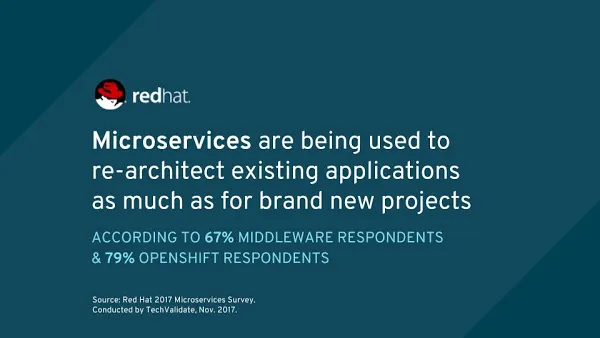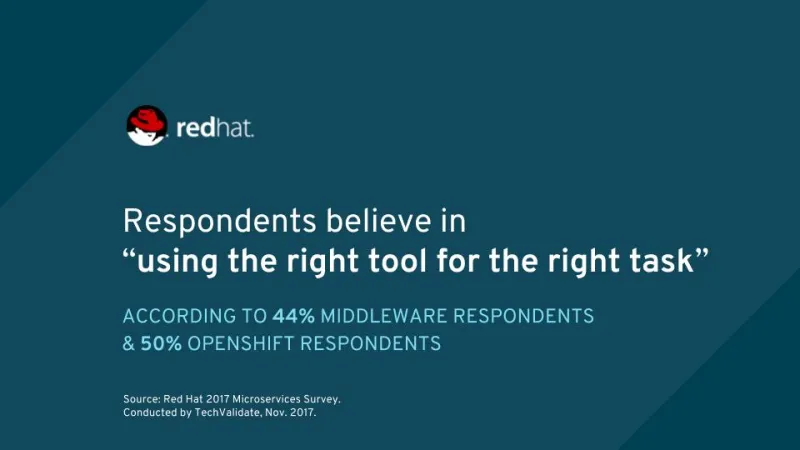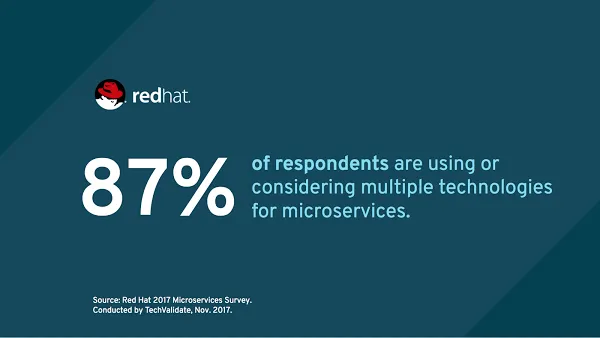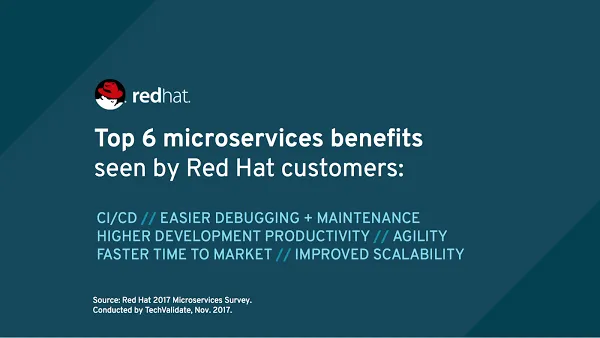During the fall of 2017, we conducted a microservices survey with our Red Hat JBoss Middleware and Red Hat OpenShift customers. From this, we were able to discover how these customers are using microservices to their advantage, what they see as some of the major benefits, what challenges exist and how to overcome them and how microservices can give respondents a competitive advantage. While these statistics are based off of a specific group of Red Hat customers, these findings give a good sense of the overall attitude toward microservices adoption and implementation. Read on to learn more about these findings.
Microservices are being used for both re-architecting existing applications and for brand new projects and initiatives
Microservices projects tend to be marketed as being best for implementing brand-new projects, without mentioning the benefits they bring to upgrading existing projects; however, the survey revealed that respondents are also using microservices to successfully re-architect existing and legacy applications. Sixty-nine (69) percent of respondents indicated that they are using microservices for both new applications and for re-architecting existing ones. Based on this data, it can be understood that microservices offers value to users throughout their IT transformations -- from updating a current portfolio to introducing brand new initiatives.

Customers prefer a multi-runtime/multi-technology/multi-framework approach for microservices
Through this survey, it became clear that there is no single runtime platform or framework that is the best for microservices. We also learned that 45 percent of respondents believe in “using the right tool for the right task,” rather than dedicating themselves to a single technology, runtime or framework.

The survey also shows that 87 percent of respondents indicated that they are using or considering multiple technologies for developing microservices.

These responses show that multi-technology solutions are becoming the norm and that more and more organizations simply want to use the right tool for the right task. This is why it is important to have multiple runtimes and frameworks, as not all technology projects function the same and most do not thrive on using the same tools.
Top benefits of microservices adoption
Respondents to our survey identified many benefits that they are already receiving as a result of implementing microservices. The top six benefits respondents noted are as follows:
- Continuous Integration (CI) / Continuous Deployment (CD)
- Agility
- Improved scalability
- Faster time-to-market
- Higher developer productivity
- Easier debugging and maintenance

Furthermore, many (33 percent) of respondents recognized the benefits within two to six months of first implementing microservices, meaning that the ramp up time is a quick process and benefits can be observed very quickly.

Challenges of implementing microservices
Implementing microservices will not solve all of your software and enterprise problems and in fact, microservices can come with its own set of challenges. According to the survey, the top four challenges to implementing microservices that respondents faced include:
- Corporate culture and organizational challenges
- Microservices management
- Diagnostics and monitoring
- Time and resources
Conversely, the top four activities that respondents identified to help mitigate these challenges were:
- Developing/implementing in-house microservices tooling
- Re-organization
- Working with vendor subject matter experts / Using a vendor as a trusted advisor
- Purchasing or using a microservices platform / solution
Respondents to the survey indicated that they have been relying on vendors as their trusted advisors when it comes to microservices. In addition, many responded that a reorganization was a mitigating activity to get past the microservices challenges in relation to corporate culture. This indicates that it is critical to have a plan in place to evaluate microservices solutions that are available in the market and do due diligence to select the one that best fits individual requirements. The reorganization of teams to incorporate new technologies and inspire change is also a recommended course of action.

Introducing microservices can be disruptive to the way organizations are used to working; however, the results from this survey are promising. These respondents – and we would argue the industry at large – understand both the benefits and challenges of microservices, and are adapting their application strategies accordingly to better meet the demands of the new digital economy.
À propos de l'auteur
Red Hat is the world’s leading provider of enterprise open source solutions, using a community-powered approach to deliver high-performing Linux, cloud, container, and Kubernetes technologies.
Plus de résultats similaires
Evolving our ServiceNow integration: Sunsetting the Notification Service for more capable alternatives
Beyond the horizon: Navigating the bridge between today's tech and tomorrow's AI
Communicating the Value of Connecting Systems | Code Comments
Parcourir par canal
Automatisation
Les dernières nouveautés en matière d'automatisation informatique pour les technologies, les équipes et les environnements
Intelligence artificielle
Actualité sur les plateformes qui permettent aux clients d'exécuter des charges de travail d'IA sur tout type d'environnement
Cloud hybride ouvert
Découvrez comment créer un avenir flexible grâce au cloud hybride
Sécurité
Les dernières actualités sur la façon dont nous réduisons les risques dans tous les environnements et technologies
Edge computing
Actualité sur les plateformes qui simplifient les opérations en périphérie
Infrastructure
Les dernières nouveautés sur la plateforme Linux d'entreprise leader au monde
Applications
À l’intérieur de nos solutions aux défis d’application les plus difficiles
Virtualisation
L'avenir de la virtualisation d'entreprise pour vos charges de travail sur site ou sur le cloud
